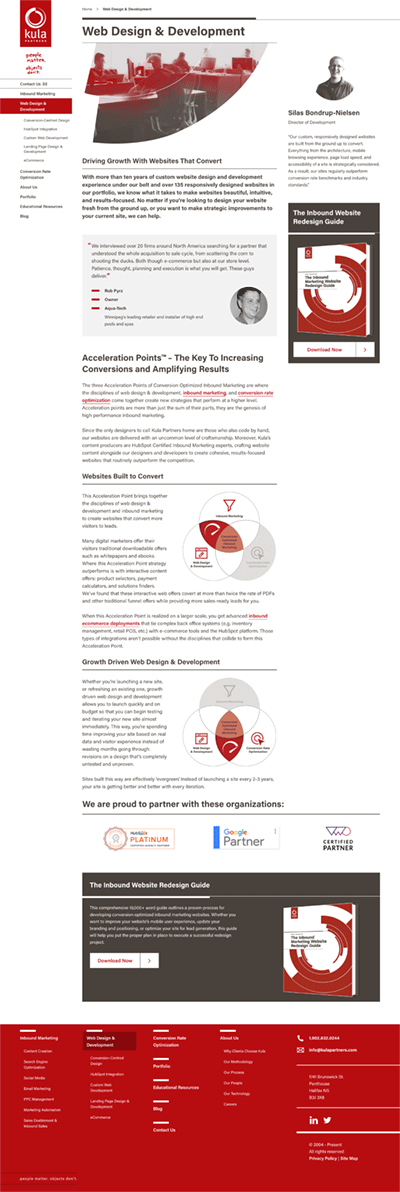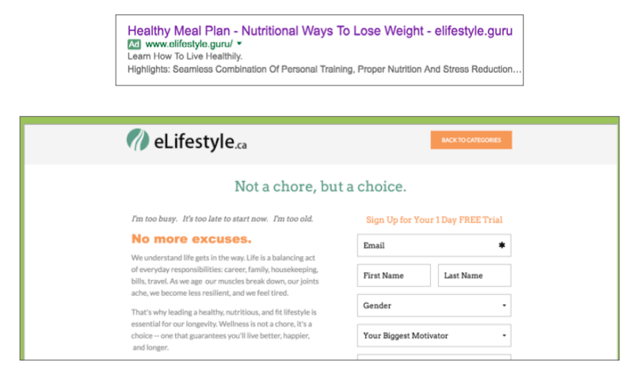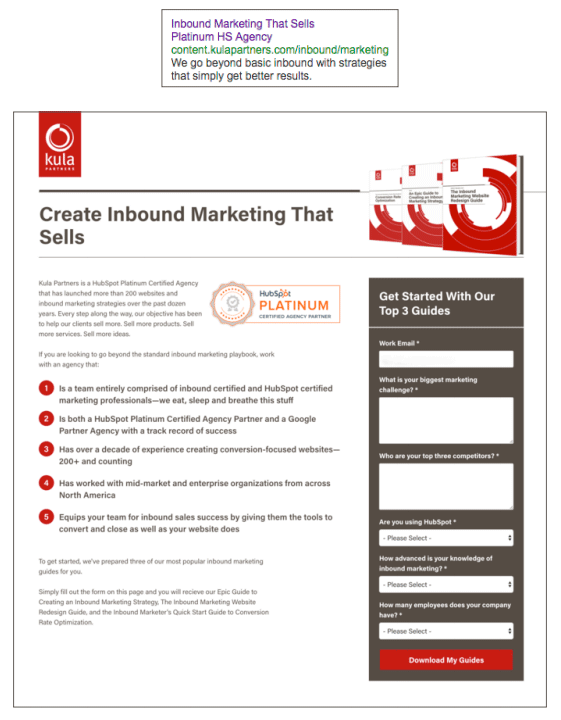Introduction
There’s no way around it: successful inbound marketers absolutely must know how to write compelling content that successfully converts nameless and faceless site visitors into contacts. And, when we say content, we aren’t just talking about your main site pages: we’re talking about landing pages, calls to action, blog posts, funnel offers, and more.
Crafting website copy that sells isn’t about yelling “BUY NOW” to anyone who will listen. It’s about serving helpful, detailed information to the visitors who find your site, and providing specific facts and guidance to demonstrate how you’ll help them address their pain points or achieve their objectives. With web content growing exponentially each year, inbound marketers and copywriters are under more pressure than ever to create valuable, helpful content that generates leads and wins more customers.
Creating website content that converts is straightforward when you follow a few simple rules. In this guide, you’ll find details around three core principles:
- First, nail the basics with regard to structure, brand tone, persona focus, and calls to action.
- Second, design landing pages to minimize distractions and guide users to one specific goal.
- Finally, wherever possible, create content that appeals to visitors based on where they are in the buyer’s journey.
About Kula Partners
Kula Partners helps leading B2B manufacturers craft digital experiences that transform how they engage buyers, serve customers, and outpace their competition online. We are headquartered in Halifax, Nova Scotia, Canada and work primarily with North American-based manufacturing clients marketing within complex B2B selling environments.
Expecting a PDF?
We created this eBook as a web page for better mobile optimization, accessibility, & maintenance. Remember, you can bookmark this page for future reading, save it to the reading list on your mobile device, or print a hard copy. If you'd still like a PDF version of this eBook, you can download it here:
 Print This Page
Print This Page
Table of Contents
Site Content 101: Inbound Best Practices
Lead with the Benefits
Visitors have come to your site to learn about how your product will help them solve their specific issues. Don’t make them work to find the information they need. Clearly showcase how your offering makes it possible for them to achieve their objectives. Don’t obscure the “meat” by talking too much (or exclusively) about how excited your organization is about the product, or how you’ve come up with it. Be obvious about how your offering will help them satisfy their pain points.
There’s an important difference between benefits and features. A feature is a characteristic of the product, like “this black dress is made with stretchy fabric”. A benefit is how that feature fundamentally meets your prospects’ requirements, like “this stretchy black dress hugs curves, so you can flaunt your best assets and move around the dance floor with ease.” Features won’t connect with your site visitors in the same way a benefit can help them to imagine actually using your offering.
Here’s a helpful way to identify whether your content is too focused on you:
- Choose one colour to highlight how many times you’ve mentioned your organization.
- Use another colour to highlight how many times you’ve referenced a benefit for your audience.
- If your company colour is more prevalent than your benefits colour, consider adding in more content that speaks to them, as it will be more likely to engage the reader.
Plain Language Always Wins
Copy should avoid buzzwords, jargon, or highly specialized industry-specific terms, as these can be unfamiliar to visitors and will obscure your message. It can be easy to get swept up in the language you use daily when writing site content, but your potential customers likely won’t actually understand what you mean when you say:
We’ve evolved a laser focused, frictionless process to maximize human capital. This game changer intrinsically improves enterprise-wide productivity and can be conveniently customized to your high standards across all applications, continually driving future-proof collaboration and idea-sharing within teams!
Instead, try saying:
Our 8-step process helps clients train and retain their in-house talent, increasing productivity and engagement, reducing sick days and saving money. Our process evaluates your team’s skills, goals and growth paths to create custom training programs that help them work together to achieve personal and team objectives.
Jargon is harmful because it negatively impacts comprehension—and you want your visitors to convert, not play “Buzzword Bingo” when they land on your site! In order to support conversion, readers need to clearly understand what you’re offering, how you’ll help them, and why they should choose you over your competitors.

A test to help with this is the “5 Second Test”. Particularly useful for headlines and landing pages, the 5 Second Test asks whether someone looking at your page for 5 seconds would understand what your offering is. If what you do isn’t obvious in that short a time, your content needs to be updated.
Not sure where your content stands? Unbounce has created a Dejargonator extension for Chrome.
Write for Your Personas and Address Where They Are in Their Journey
You’ve researched and defined your buyer personas to inform how key areas of your site and inbound strategy—from design, to campaigns and conversion points—will help your ideal customers. Your buyer personas must also be reflected in the site content. Throughout the copy, the persona’s goals, responsibilities, and objections should be addressed and their questions answered. After reading your copy, they should end up with a clear understanding of how your offering helps them solve their problems.
You’ll know from your persona development exercise whether they are the final decision maker, in a high-pressure role, highly educated, or out of their depth with regard to your offering—and your copy should be written to reflect their needs. The tone should be consistent throughout the site and speak to your personas at their level. For example, should the copy be conversational or overtly technical, professional or friendly, highly advanced or break down complex information into more easily digestible pieces?
By crafting the copy to speak to the reader’s needs, and demonstrating how your offering helps, it makes it much easier for them to understand why they should choose you instead of a competitor. As noted above, readers want to know how your offering will help them specifically, so it’s important to write it from this perspective. To help accomplish this, the copy should be written to demonstrate how your offering will address the users’ particular needs, instead of about the offering in a vague or general sense.
Often, site pages correspond to a particular funnel stage. The homepage and top level section pages will often be a first touchpoint for new visitors, particularly those arriving via Organic search. These pages are usually Top of Funnel (TOF), and created for a wider audience. Here, you’ll want to surface broader offers, such as an ebook or a guide.
Pages that talk about pricing, demonstrate a tool’s specific application and use cases, or explain “Why Choose Us?” are examples of more bottom of funnel (BOF) pages. Offering a consultation or free trial as conversion points would make sense here.
Show Your Brand’s True Colours
Content should use active voice instead of passive voice wherever possible. Writing in the active voice is easier to read and makes your content more clear.
For example:
Active: The VP of Marketing wrote the email
Passive: The email was written by the VP of Marketing
Active: I gave the dog a tummy rub
Passive: The dog was given a tummy rub by me
Active: The woman ate the apple
Passive: The apple was eaten by the woman
Call Visitors to Action
The content throughout your site should be written to entice visitors to convert. By using verbs and instructions like “Download the Guide!”, or “Get Your Quote Today!”, visitors will be inspired to gain more information and will know the step they need to take to get it. Further, by clearly explaining the benefits of the product and then showing a visitor a corresponding high quality offer, they’ll be more likely to convert.
Every page should have at least one Call to Action (CTA). The call to action should reflect the persona and funnel stage of that page. On a page that discusses pricing (a mid to bottom of funnel page), a CTA of “Request a Quote” would make sense. In contrast, that same CTA might not make sense on a top of funnel page where leads and potential leads are still looking for further information about how a particular product or service can solve their problems. In this case, consider creating a guide or checklist that helps the user understand how they could benefit from the product, or provide them with further examples of how the offering can help solve their issues. For example, a travel company might provide visitors looking for affordable family travel ideas with an ebook that features top picks for inexpensive resorts that cater to kids and their parents.
This image below shows the pieces of content that are most closely tied to the top, middle and bottom of funnel stages:

Short Pages vs. Master Works
For core site pages, like top level and child pages, aim for an average minimum length of 500 words. In theory, this will provide users with enough content to gain a clear understanding of the features and benefits of your offering. It should also tell Google that there is sufficient content here to be useful to a reader. Same goes for blog posts: no less than 450 words, with this length as a good benchmark for the shortest post. Here’s an example of a shorter page on Kula’s website:

There is no maximum length. Increasingly, studies show that the more high quality content on a page, the better. Longer content also makes it possible to place a number of relevant conversion points throughout the page, providing multiple opportunities for leads to convert. Here’s an example of a longer page from the Kula site:

Craft Each Page with a Keyword Focus
Each page and post should be designed to focus almost exclusively on one target keyword and its relevant “semantic keywords”, or closely related variations. Here’s an example:
Primary keyword:
- Healthy dinner recipes
Semantic variations:
- Low cal supper recipes to lose weight
- Low cal meal recipes pinterest
- Healthy dinner ideas for two
- Vegetarian recipes for diets
- Easy fast healthy food ideas
- Healthy chicken meal recipes
- Low calorie choices
- Easy recipes to lose weight fast
All the elements on that page should then work together to clearly indicate to a user—and to search engines like Google—that they can find useful information about “healthy dinner recipes” on this page. To that end, there are a number of other areas on the page where the keyword should appear in addition to the core page copy:
- Headers: The target keyword and its variations should also appear several times in headers throughout the copy. It should be noted that headers are a great tool to highlight a page’s core points or sections and help make it easier to skim. An H1 or <title> tag should only appear once per page. Usually, it is reserved for the page’s title. The remaining headers on the page should be H2 or below.
- First Paragraph: The first paragraph should contain the keyword, showing search engines and humans the relative importance of this term and further demonstrating that it is at the core of the page’s content. Ideally, the target keyword for the page will appear within the first sentence, and at minimum within the first 100 words.
- Throughout the Copy: There is no minimum requirement for the number of times to use a keyword, keeping in mind that using the keyword too many times results in diminishing gains. If the keyword is “stuffed” or over-represented in the copy, people will find it hard to read and it can be perceived as spammy by search engines—both of which can result in reduced rankings. A good rule of thumb is to keep the primary keyword density to about 3% of the page's or post's total length, and add in the semantic variations throughout as it makes sense.
- Unique Content: You’ve created your website to reflect your business’ distinct offering, and your copy should follow suit. Make sure your site content is unique. By “unique content”, we mean that no two pages can have identical content, paragraphs copied from other sites, or boilerplate copy repeated across pages. In practice, this means that two pages can reference the same topic, but they cannot use the exact same phrasing from other pages on your site or any other site. This is very important as sites with duplicate pages often won’t be indexed, limiting their chances to appear in the results pages.
Landing Pages that Engage the 95%
A Unique Value Proposition
Clearly Demonstrate the Benefits
Compelling Visuals
Include visuals on the page to provide leads with an idea of what they’ll get once they’ve converted. Consider using the document cover, or pulling out images or screenshots of the contents. A more strategic use of visuals is to feature images that direct the eye toward the action you want them to take, like pointing to the form.
Social Proof
Where possible, include some form of social proof—about your company’s track record, certifications, awards, partnerships, testimonials, information about the author, or even about the piece itself. It’s no surprise that landing pages featuring this kind of validator have higher conversion rates: “if someone else got it and liked it, I probably will, too”.
Here’s an example of Kula’s landing pages, which include testimonials and partner badges.

One Clear Conversion Goal
Consistent Language
BONUS: Landing Pages for Paid Campaigns
When creating custom landing pages for Paid Search or Paid Social campaigns, ensure that the language on your landing page is consistent with the language you use in your ads. For example, if ads are created around “healthy meal plans” but point to pages that reference a free trial, it is likely users will bounce, reducing the conversion rate of the page.


Putting the Text in Contextual Marketing
Contextual content (or Smart Content) gives marketers an incredible opportunity to customize content so that leads see a personalized version of your pages. This makes it possible to tailor the content that is delivered to your visitors based on a number of factors. The first time a visitor lands on your site, they’ll see one version of your content. As you learn more about them, including their previous conversions or preferred browsing device, they’ll be shown various other versions of that page.
Smart Content alters the content displayed within rich text, form, custom HTML, and/or CTA modules depending on viewer characteristics. Much like HubSpot’s Smart Calls-to-Action (CTAs), Smart Content is powered by Smart Lists and Lifecycle Stages. By creating Smart Lists that recognize your different lifecycle stages, you can customize the content that people in each lifecycle stage will see. When a visitor comes to your website, they bring some context with them for that session, including any cookie that was attached to them from a previous session on your website. Smart content can also be catered around anonymous visitors based on their country, device type, or referral source.
HubSpot reports that targeted CTA’s performed 42% better than generic ones—a great reason to implement Smart Content on at least several of your higher value pages.
Simply put, create site content that speaks to visitors depending on where they’re coming from, where they are in the process, and how they’ve previously engaged with you. You’ll greatly increase the chances that those visitors will turn into leads, and then into customers.
Start Creating Content that Converts
Conversion-friendly site copy isn’t rocket science, but at the same time, it isn’t always easy. Writing simple, effective, and persuasive copy that ticks all the SEO boxes takes practice. For teams without an inbound copywriter, small teams inundated with other priorities or as the sole marketer on a team, creating copy that attracts visitors and guides them through the funnel can be a real challenge.
If you’d like to chat about how Kula can help you achieve your content objectives, or discuss how conversion-focused content fits into your wider inbound marketing strategy, get in touch with our experts today!
Continue Reading the Guide to Writing Website Content that Converts
Contact Us Today
We are a cross-functional team of inbound strategists, conversion optimizers, writers, designers, developers, project managers, and quality assurance experts. Our headquarters are located in beautiful downtown Halifax, Nova Scotia.
If you’d like to learn more about our services or discuss how we might be able to work together, please fill out the form below. Jesse Mawhinney—our Engagement Director—will review your message, do some research about your organization, and contact you soon.
